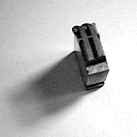Ligature
Metal
Date unknown
Purchased at an estate sale in Rochester, NY
A ligature is a special double character in a font representing two letters as one. In modern typography, the most common ligatures are: fi, fl, ffi, ffl, and sometimes ff. Others include the vowel pairs ae and oe, and morerarely, ct, st, and sp. Ligatures can be found throughout medieval hand lettering and calligraphy. Indeed, Gutenberg’s font, which was an imitation of the popular `black letter’ design of northern European scribes, contained several dozen ligatures.
In the rapidly evolving printing trade of the time, ligatures were not required by technology, rather they provided continuity in typographic design. It is conceivable that efficiency was a further incentive, as skilled compositors could obviously set type faster when commonly occurring letter combinations were pre-joined. This tradition of ligature usage continued unabated until the late nineteenth century when the invention of the punchcutting machine resulted in new composition technologies. One of the interesting side effects of hot metal composition was that certain characters tended to break when they occurred next to one another. Ligatures were no longer a matter of aesthetics or productivity, they were essential for machine composition.
